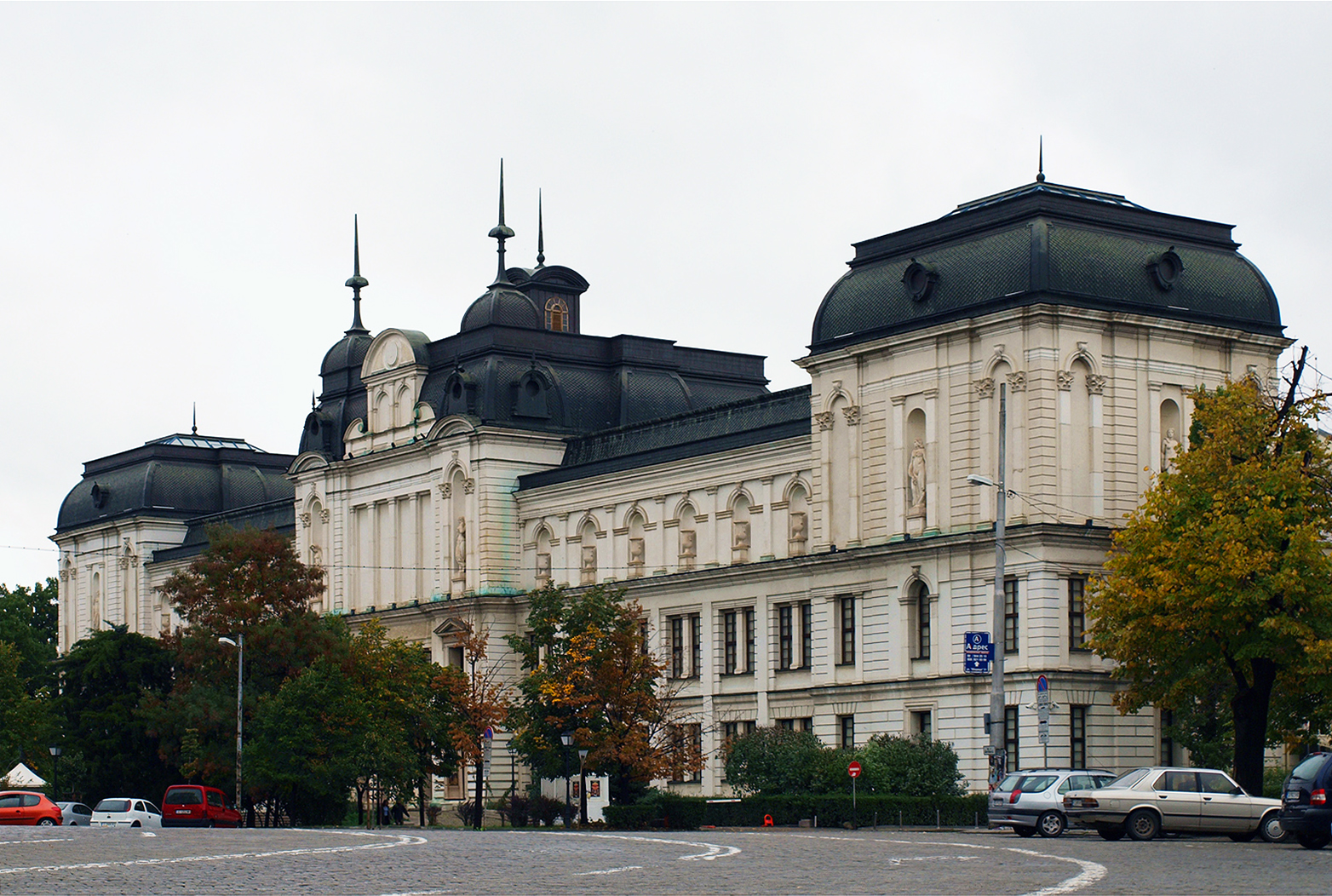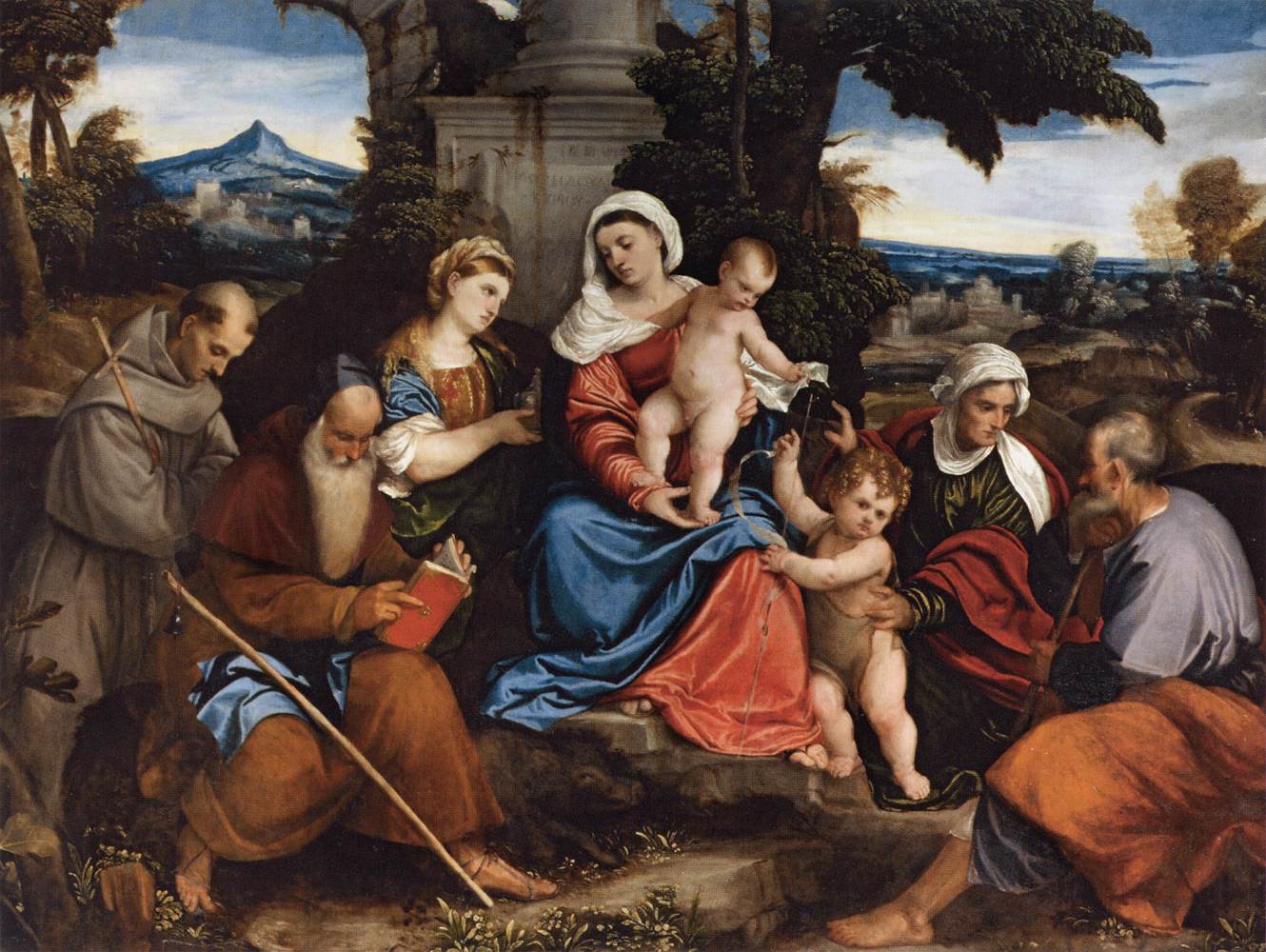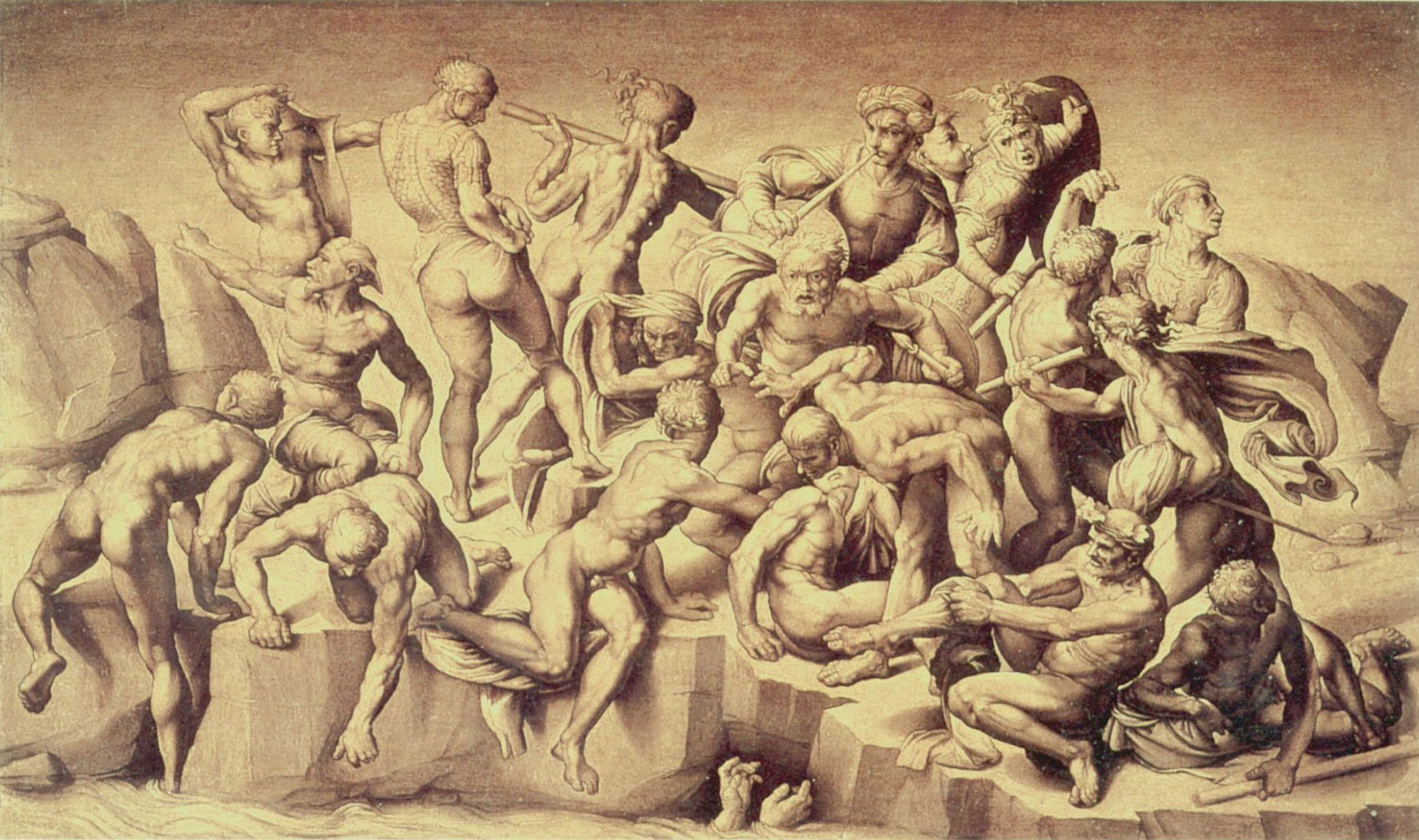|
Jacopo Palma
Palma Vecchio ( – 30 July 1528), born Jacopo Palma, also known as Jacopo Negretti, was a Venetian painter of the High Renaissance, Italian High Renaissance. He is called Palma Vecchio in English and Palma il Vecchio in Italian ("Palma the Elder") to distinguish him from Palma il Giovane ("Palma the Younger"), his great-nephew, who was also a painter. Life Palma was born at Serina, Lombardy, Serina Alta near Bergamo, a dependency of the Republic of Venice, but his recorded career all took place in or near Venice. He is first recorded in Venice in 1510, but had probably already been there for some time.Freedberg, 160 He was perhaps apprenticed to Andrea Previtali, who also came from Bergamo, and who returned there in 1511.Rylands Palma's earlier works show the influence of Giovanni Bellini, Previtali's master and by then the aged ''doyen'' of Venetian painting, but Palma came to follow the new style and subjects pioneered by Giorgione and Titian. After the deaths of Giovan ... [...More Info...] [...Related Items...] OR: [Wikipedia] [Google] [Baidu] |
Serina, Lombardy
Serina is a ''comune'' (municipality) in the Province of Bergamo in the Italy, Italian region of Lombardy, located about northeast of Milan and about northeast of Bergamo. As of 31 December 2004, it had a population of 2,214 and an area of .All demographics and other statistics: Italian statistical institute National Institute of Statistics (Italy), Istat. The municipality of Serina contains the ''frazione, frazioni'' (subdivisions, mainly villages and hamlets) Corone, Lepreno, Bagnella, and Valpiana. Serina borders the following municipalities: Algua, Cornalba, Costa di Serina, Dossena, Oltre il Colle, Roncobello, San Pellegrino Terme. Demographic evolution Colors= id:lightgrey value:gray(0.9) id:darkgrey value:gray(0.8) id:sfondo value:rgb(1,1,1) id:barra value:rgb(0.6,0.7,0.8) ImageSize = width:455 height:303 PlotArea = left:50 bottom:50 top:30 right:30 DateFormat = x.y Period = from:0 till:3000 TimeAxis = orientation:vertical AlignBars = justify Scale ... [...More Info...] [...Related Items...] OR: [Wikipedia] [Google] [Baidu] |
Donor Portrait
A donor portrait or votive portrait is a portrait in a larger painting or other work showing the person who commissioned and paid for the image, or a member of his, or (much more rarely) her, family. ''Donor portrait'' usually refers to the portrait or portraits of donors alone, as a section of a larger work, whereas ''votive portrait'' may often refer to a whole work of art intended as an ex-voto, including for example a Madonna, especially if the donor is very prominent. The terms are not used very consistently by art historians, as Angela Marisol Roberts points out, and may also be used for smaller religious subjects that were probably made to be retained by the commissioner rather than donated to a church. Donor portraits are very common in religious works of art, especially paintings, of the Middle Ages and Renaissance, the donor usually shown kneeling to one side, in the foreground of the image. Often, even late into the Renaissance, the donor portraits, especially when of ... [...More Info...] [...Related Items...] OR: [Wikipedia] [Google] [Baidu] |
Brera Gallery
The Pinacoteca di Brera ("Brera Art Gallery") is the main public gallery for paintings in Milan, Italy. It contains one of the foremost collections of Italian paintings from the 13th to the 20th century, an outgrowth of the cultural program of the Brera Academy, which shares the site in the Palazzo Brera. History The Palazzo Brera owes its name to the Germanic ''braida'', indicating a grassy opening in the city structure: compare the ''Bra'' of Verona. The convent on the site passed to the Jesuits (1572), then underwent a radical rebuilding by Francesco Maria Richini (1627–28). When the Jesuits were disbanded in 1773, the palazzo remained the seat of the astronomical Observatory and the Braidense National Library founded by the Jesuits. In 1774 the herbarium of the new botanical garden was added. The buildings were extended to designs by Giuseppe Piermarini, who was appointed professor in the Academy when it was formally founded in 1776, with Giuseppe Parini as dean. Pier ... [...More Info...] [...Related Items...] OR: [Wikipedia] [Google] [Baidu] |
National Gallery For Foreign Art
The National Gallery for Foreign Art (, ''Natsionalna galeriya za chuzhdestranno izkustvo'') of Bulgaria is a gallery located on St. Alexander Nevsky Square in Sofia. It serves as the country's national institution for non-Bulgarian art. It is situated in the 19th-century Neoclassic edifice of the former Royal Printing Office. History The edifice of the NGFA was built between 1882 and 1884 during the rule of knyaz Alexander Battenberg to the designs of Austrian architect Friedrich Schwanberg and reconstructed after it suffered significant damage during the bombing of Sofia in World War II. The gallery itself was founded on 5 November 1985 as the art gallery of the Sts. Cyril and Methodius Foundation, its stock being later enlarged by donations, as well as by the addition of the National Art Gallery's foreign art section. A large portion of the donations were made through the "13 Centuries of Bulgarian Statehood" fund, established by Lyudmila Zhivkova in the 1980s. Since Ma ... [...More Info...] [...Related Items...] OR: [Wikipedia] [Google] [Baidu] |
Dresden Gallery
Dresden (; ; Upper Saxon German, Upper Saxon: ''Dräsdn''; , ) is the capital city of the States of Germany, German state of Saxony and its second most populous city after Leipzig. It is the List of cities in Germany by population, 12th most populous city of Germany, the fourth largest by area (after Berlin, Hamburg, and Cologne), and the third-most populous city in the area of former East Germany, after Berlin and Leipzig. Dresden's urban area comprises the towns of Freital, Pirna, Radebeul, Meissen, Coswig, Saxony, Coswig, Radeberg, and Heidenau and has around 790,000 inhabitants. The Dresden metropolitan area has approximately 1.34 million inhabitants. Dresden is the second largest city on the River Elbe after Hamburg. Most of the city's population lives in the Dresden Basin, Elbe Valley, but a large, albeit very sparsely populated, area of the city east of the Elbe lies in the West Lusatian Hill Country and Uplands (the westernmost part of the Sudetes) and thus in Lusatia. ... [...More Info...] [...Related Items...] OR: [Wikipedia] [Google] [Baidu] |
Santa Maria Formosa
Santa Maria Formosa, formally The Church of the Purification of Mary, is a church in Venice, northern Italy. It was erected in 1492 under the design by Renaissance architect Mauro Codussi. It lies on the site of a previous church dating from the 7th century, which, according to tradition, was one of the eight founded by San Magno, bishop of Oderzo. The name "formosa" relates to an alleged appearance of the Holy Virgin disguised as a voluptuous woman1. Exterior The plan is on the Latin cross, with a nave and two aisles. The two façades were commissioned in 1542, the Renaissance-style one facing the canal, and 1604, the Baroque one facing the nearby square. The dome of the church was rebuilt after falling in during an earthquake in 1688. Santa Maria Formosa Facciata e campanile2.jpg, West facade Santa Maria Formosa - Monumento di Vicenzo Cappello - Domenico di Pietro Grazioli.jpg, Monument to Vincenzo Cappello 0 Venise, grotesque en pierre sculptée - Santa Maria Formosa.JP ... [...More Info...] [...Related Items...] OR: [Wikipedia] [Google] [Baidu] |
Diana And Callisto - Palma Vecchio
Diana most commonly refers to: * Diana (name), given name (including a list of people with the name) * Diana (mythology), ancient Roman goddess of the hunt and wild animals; later associated with the Moon * Diana, Princess of Wales (1961–1997), formerly Lady Diana Spencer, activist, philanthropist, and member of the British royal family Diana may also refer to: Places and jurisdictions Africa * Diana (see), a town and commune in Souk Ahras Province in north-eastern Algeria * Diana's Peak, the highest point on the island of Saint Helena * Diana Region, a region in Madagascar * Diana Veteranorum, an ancient city, former bishopric and present Latin Catholic titular see in Algeria Asia * Diana, Iraq, a town in Iraqi Kurdistan Europe * Diana (Rozvadov), an almost abandoned settlement in the Czech Republic * Diana, Silesian Voivodeship, a village in south Poland * Diana Fort, an ancient Roman castrum in Serbia * Diana Park, a small park in Helsinki, Finland * Diana Strait, ... [...More Info...] [...Related Items...] OR: [Wikipedia] [Google] [Baidu] |
Giovanni Busi
Giovanni Cariani (–1547), also known as Giovanni Busi or Il Cariani, was an Italian painter of the high-Renaissance, active in Venice and the Venetian mainland, including Bergamo, thought to be his native city. Overview His father, also Giovanni Busi, was born in Fuipiano Al Brembo which is a hamlet of San Giovanni Bianco (Bergamo), and was appointed a local magistrate for the Venetian authorities. His son, also born in Fuipiano Al Brembo, is known to have lived in Venice starting in 1509, and may have trained with either Giovanni Bellini or Giorgione, and almost certainly was influenced by them. Though he worked often in Bergamo, he died in Venice in 1547. He was strongly influenced by Palma il Vecchio, but had a provincial love of scenery as seen in his ''Sacra conversazione with a youthful donor''. While working in Bergamo (1517–1523), he likely overlapped with Lorenzo Lotto, who worked there from 1513 to 1525. ''Cariani and the Courtesans'' The 1987 BBC Two televisio ... [...More Info...] [...Related Items...] OR: [Wikipedia] [Google] [Baidu] |
Bonifazio Pitati
Bonifazio Veronese, born Bonifazio de' Pitati (1487 – 19 October 1553), was a Venetian Renaissance painter who was active in the Venetian Republic. His work had an important influence on the younger generation of painters in Venice, particularly Andrea Schiavone and Jacopo Tintoretto.Thomas Nichols. "Pitati, Bonifazio de’." Grove Art Online. Oxford Art Online. Oxford University Press. Web. 28 Dec. 2016 Life The artist was born in Verona from which his family moved to Venice around 1505. Here, the young artist reputedly trained under Palma il Vecchio. He was initially a close follower of il Vecchio. He ran a large workshop in Venice, which could execute small devotional works as well as large painting projects. His early work also shows his knowledge of Giorgione and TitianPitati, ... [...More Info...] [...Related Items...] OR: [Wikipedia] [Google] [Baidu] |
Mannerism
Mannerism is a style in European art that emerged in the later years of the Italian High Renaissance around 1520, spreading by about 1530 and lasting until about the end of the 16th century in Italy, when the Baroque style largely replaced it. Northern Mannerism continued into the early 17th century. Mannerism encompasses a variety of approaches influenced by, and reacting to, the harmonious ideals associated with artists such as Leonardo da Vinci, Raphael, Vasari, and early Michelangelo. Where High Renaissance art emphasizes proportion, balance, and ideal beauty, Mannerism exaggerates such qualities, often resulting in compositions that are asymmetrical or unnaturally elegant. Notable for its artificial (as opposed to naturalistic) qualities, this artistic style privileges compositional tension and instability rather than the balance and clarity of earlier Renaissance painting. Mannerism in literature and music is notable for its highly florid style and intellectual sophist ... [...More Info...] [...Related Items...] OR: [Wikipedia] [Google] [Baidu] |
Michelangelo
Michelangelo di Lodovico Buonarroti Simoni (6March 147518February 1564), known mononymously as Michelangelo, was an Italian sculptor, painter, architect, and poet of the High Renaissance. Born in the Republic of Florence, his work was inspired by models from classical antiquity and had a lasting influence on Western art. Michelangelo's creative abilities and mastery in a range of artistic arenas define him as an archetypal Renaissance man, along with his rival and elder contemporary, Leonardo da Vinci. Given the sheer volume of surviving correspondence, sketches, and reminiscences, Michelangelo is one of the best-documented artists of the 16th century. He was lauded by contemporary biographers as the most accomplished artist of his era. Michelangelo achieved fame early. Two of his best-known works, the ''Pietà (Michelangelo), Pietà'' and ''David (Michelangelo), David'', were sculpted before the age of 30. Although he did not consider himself a painter, Michelangelo created ... [...More Info...] [...Related Items...] OR: [Wikipedia] [Google] [Baidu] |
Pinacoteca Di Brera
The Pinacoteca di Brera ("Brera Art Gallery") is the main public gallery for paintings in Milan, Italy. It contains one of the foremost collections of Italian paintings from the 13th to the 20th century, an outgrowth of the cultural program of the Brera Academy, which shares the site in the Palazzo Brera. History The Palazzo Brera owes its name to the Germanic ''braida'', indicating a grassy opening in the city structure: compare the ''Bra'' of Verona. The convent on the site passed to the Jesuits (1572), then underwent a radical rebuilding by Francesco Maria Richini (1627–28). When the Jesuits were disbanded in 1773, the palazzo remained the seat of the astronomical Observatory and the Braidense National Library founded by the Jesuits. In 1774 the herbarium of the new botanical garden was added. The buildings were extended to designs by Giuseppe Piermarini, who was appointed professor in the Academy when it was formally founded in 1776, with Giuseppe Parini as dean. ... [...More Info...] [...Related Items...] OR: [Wikipedia] [Google] [Baidu] |








